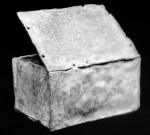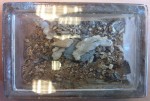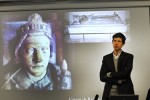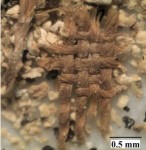 King Richard I of England, dubbed the Lionheart for his bravery in combat, died not in battle but while walking around a castle he was besieging examining the work of his offensive engineers. The castle of Châlus-Chabrol, close to Limoges in central France, was defended by crossbowmen, but they were a raggedy crew by this time and Richard had no qualms about walking the perimeter of the castle wearing no chain mail. Prideth goeth before a you-know-what, and he was struck in his left shoulder by a crossbow bolt. The doctor who removed it did so sloppily and soon infection set in. On April 6th, 1199, 12 days after he was wounded, Richard the Lionheart died.
King Richard I of England, dubbed the Lionheart for his bravery in combat, died not in battle but while walking around a castle he was besieging examining the work of his offensive engineers. The castle of Châlus-Chabrol, close to Limoges in central France, was defended by crossbowmen, but they were a raggedy crew by this time and Richard had no qualms about walking the perimeter of the castle wearing no chain mail. Prideth goeth before a you-know-what, and he was struck in his left shoulder by a crossbow bolt. The doctor who removed it did so sloppily and soon infection set in. On April 6th, 1199, 12 days after he was wounded, Richard the Lionheart died.
 As was a common practice for the aristocracy at the time, his body was partitioned. His entrails were placed in a coffin and buried in the Châlus castle chapel. His body was buried at Fontevraud Abbey at the feet of his father King Henri II. Later the remains of his formidable mother Eleanor of Aquitaine would join them there. His heart was embalmed, wrapped in linen, then placed in a lead case. That case was held in an elegant silver vessel in the cathedral of Notre-Dame in Rouen, capital of the duchy of Normandy.
As was a common practice for the aristocracy at the time, his body was partitioned. His entrails were placed in a coffin and buried in the Châlus castle chapel. His body was buried at Fontevraud Abbey at the feet of his father King Henri II. Later the remains of his formidable mother Eleanor of Aquitaine would join them there. His heart was embalmed, wrapped in linen, then placed in a lead case. That case was held in an elegant silver vessel in the cathedral of Notre-Dame in Rouen, capital of the duchy of Normandy.
The silver container was melted down by Blanche of Castile, granddaughter of Henry II and Eleanor of Aquitaine and mother of King Louis IX of France in 1250 to raise money for Louis’ ransom after he was captured by Egyptian forces during the Seventh Crusade. An appropriate fate, if you think about it, given how much money Eleanor had extorted out his English subjects to ransom Richard when he was imprisoned by Duke Leopold of Austria and Holy Roman Emperor Henry VI on his way back from the Third Crusade. The embalmed heart was kept in a lead case.
 On July 31st, 1838, a local historian with the mellifluous name of Achille Deville unearthed the lead box near Richard’s effigy in the course of excavations at the Rouen cathedral. The box was still sealed and bore a Latin inscription: “HIC IACET COR RICARDI REGIS ANGLORUM” or “Here lies the heart of Richard, King of the English” in a font characteristic of the 12th-13th century. The remains inside were no longer recognizable as a heart. It had decayed into a brown-whitish powder.
On July 31st, 1838, a local historian with the mellifluous name of Achille Deville unearthed the lead box near Richard’s effigy in the course of excavations at the Rouen cathedral. The box was still sealed and bore a Latin inscription: “HIC IACET COR RICARDI REGIS ANGLORUM” or “Here lies the heart of Richard, King of the English” in a font characteristic of the 12th-13th century. The remains inside were no longer recognizable as a heart. It had decayed into a brown-whitish powder.
The powder and fragments of linen that were all that remained of the Lionheart were transferred to a more airtight crystal box and placed in Rouen’s Departmental Museum of Antiquities. They are not and likely will never again be on display. The museum’s curator Caroline Dorion-Peyronnet explains why: “Visually, it is not something very pretty to present. It’s dust, it looks like nothing.”
 It may look like nothing, but it’s definitely something, especially to our indefatigable forensic anthropologist friend Philippe Charlier, who when not conducting autopsies on modern Parisian cadavers enjoys examining ancient teratomas, a royal mistress who overdosed on gold, the mummified head of Henry IV and the dried blood of Louis XVI. In May of 2012, he turned his sights on the heart of Richard, hoping to learn more about 12th century embalming techniques, and in a very long shot, to find out which bacterium caused the sepsis that killed the king. On Thursday the results of his examination were published in Scientific Reports.
It may look like nothing, but it’s definitely something, especially to our indefatigable forensic anthropologist friend Philippe Charlier, who when not conducting autopsies on modern Parisian cadavers enjoys examining ancient teratomas, a royal mistress who overdosed on gold, the mummified head of Henry IV and the dried blood of Louis XVI. In May of 2012, he turned his sights on the heart of Richard, hoping to learn more about 12th century embalming techniques, and in a very long shot, to find out which bacterium caused the sepsis that killed the king. On Thursday the results of his examination were published in Scientific Reports.
 Museum authorities granted Charlier’s team permission to take two grams of the 80 grams inside the container, thus making Richard I’s heart the oldest embalmed hearts to be examined scientifically. The two grams would be sufficient for chemical analyses of the contents, but not for DNA testing or for radiocarbon dating. Even with a larger sample size it’s unlikely carbon dating would have returned accurate results because of contamination from the embalming materials.
Museum authorities granted Charlier’s team permission to take two grams of the 80 grams inside the container, thus making Richard I’s heart the oldest embalmed hearts to be examined scientifically. The two grams would be sufficient for chemical analyses of the contents, but not for DNA testing or for radiocarbon dating. Even with a larger sample size it’s unlikely carbon dating would have returned accurate results because of contamination from the embalming materials.
 Microscope examination found fragments of linen textiles compatible with a 12th-13th century origin, numerous vegetal cells, pollen grains, bacteria and fungi. The pollen came from myrtle, daisy, mint, pine, oak, poplar, plantain and bell-flower. Myrtle, daisy and mint were much better preserved than the others, and since the plants had to have been harvested and dried before Richard’s April death, it’s likely that they were used to embalm the heart. The other pollens are probably environmental contaminants. The bacteria and fungi appear to have grown on the sample after death. No cause of death could be ascertained.
Microscope examination found fragments of linen textiles compatible with a 12th-13th century origin, numerous vegetal cells, pollen grains, bacteria and fungi. The pollen came from myrtle, daisy, mint, pine, oak, poplar, plantain and bell-flower. Myrtle, daisy and mint were much better preserved than the others, and since the plants had to have been harvested and dried before Richard’s April death, it’s likely that they were used to embalm the heart. The other pollens are probably environmental contaminants. The bacteria and fungi appear to have grown on the sample after death. No cause of death could be ascertained.
Given these ingredients, you can see why 12th century embalmers were originally cooks. They had access to all the herbs, spices and fragrances they needed and expert understanding of their uses. They were also accustomed to butchering meat and removing offal, an important skill when bodies are being partitioned, and one that medieval doctors would have very little knowledge of because their expertise was in the writings of older doctors rather than in the guts and gore of human anatomy.
Analysis of elements found copious lead and tin, plus traces of iron, copper, mercury, antimony, bismuth, calcium and aluminium. The lead came from the reliquary, as did the tin, antimony and bismuth which are common in poorly purified medieval lead. The iron came from the box’s hardware. Mercury has never been found in lead impurities, but it has been found in the remains of medieval bodies, sometimes in very large quantities. Documentary evidence supports the use of quicksilver in treatment of cadavers. The calcium probably was added during the embalming process rather than from environmental contamination, perhaps in the form of lime which can be used as a disinfectant and desiccant. Creosote was also present. The anti-septic and preservative properties of this tar distillate were well known to medieval embalmers.
The most intriguing single find was frankincense, the white powder in the remains. Frankincense hasn’t been found in any other medieval embalmings. An expensive resin with ritual significance, frankincense was reputedly one of gifts given to the baby Jesus by the Magi and was later used to anoint his body after his death on the cross. Its use on Richard’s heart doubtless had symbolic significance, connecting the deceased temporal monarch to his spiritual one.
Apparently he needed any boost he could get. According to Henry de Sandford, Bishop of Rochester from 1227 to 1235, Richard the Lionheart spent 33 years in Purgatory for his sins. In a sermon at Sittingbourn in March 1232, before assembled nobility and the Archbishop of Canterbury, he announced:
“Rejoice in the Lord, my brethren all, and know ye assuredly, that of late there departed out of purgatory Richard sometime king of England, Stephen Langton, archbishop of Canterbury [d. 1228], and a chaplain of his, to go to the Divine Majesty. And in that day came forth no more than these three from that place of pains. Fear not to give full and assured faith to these my words, for this is now the third time it has been thus revealed to me, and to another man, and that so plainly as to banish all doubt and suspicion from my mind.”
great blog – thanks!
Thank you for reading. :thanks:
33 years precisely – amazing! 😆
That’s a significant number religiously, all those threes. Jesus was 33 when he was crucified, so Richard, the great crusader, spent Jesus’ lifetime in Purgatory. 😉
I find the Bishop of Rochester’s announcement fascinating – it was REVEALED to him that certain folks had recently got out of Purgatory! Quite a claim.I wonder how his peers took to it – was the Bish perhaps getting a bit above himself?
I can’t imagine the Archbishop of Canterbury was pleased to hear the Bishop claim special revealed knowledge that included the posthumous fate of his predecessor.
“King of the English”, not “King of England”.
Fixed, thank you. :thanks:
Not your error and did not intend to imply that it was, but one gathers that the distinction between “Rex Angliae” and “Rex Anglorum” could be a significant one in the Middle Ages and later – see the change of the title of Louis XVI from Roi de France to Roi des François, with the establishment of the constitutional monnarchy.